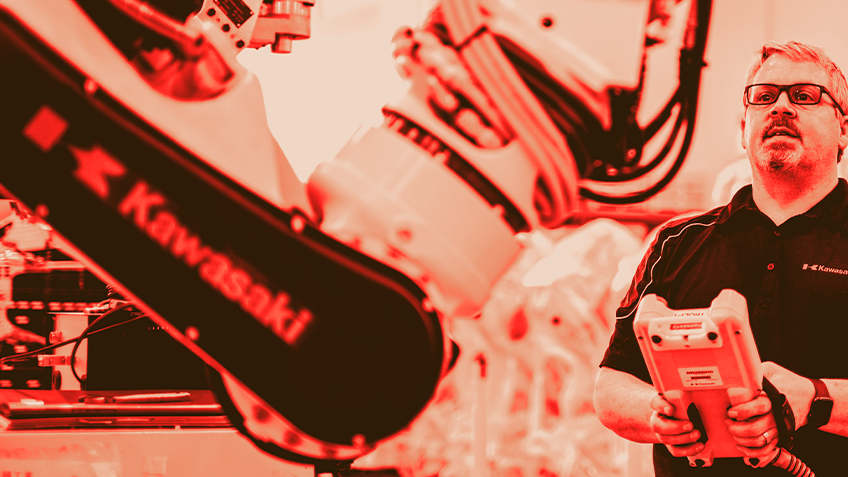By Zachary Thoma, Regional Sales Manager – Kawasaki Robotics (USA), Inc.
Taking that first step into robotic automation can be intimidating. If you’ve deployed systems in the past that can certainly help blunt the edge, but even then it can still be nerve-wracking. After all, in most cases you don’t get to buy a fully researched system that has been tried repeatedly in the same way that a press brake, table saw or car has been. You are most likely buying a completely customized system with several components made by different OEMs.
Robotic automation projects can be expensive, and if you sold this project to upper management – or maybe you are upper management – then your credibility is kind of on the line as well. In order to get the most out of your money, you want to make sure you work with experts who understand your application and industry. So, what is one to do in these scenarios? As The Ghostbusters so aptly asked: Who you gonna call?
Of course, nothing is zero risk. But there are things you can do when you’re getting started to increase your probability of success. In this article, I will guide you on what to expect, how to proceed and how you can limit your risk in your first outing with robotic automation.
Rule 1: Start Small
The first rule is simple. Don’t take your biggest, most complex problem (or headache) and set out to automate it right out of the gate. While I know this is tempting, it’s important to focus on something that you can bite off and chew a little easier.
Why? Completing a robotic automation project is a bit like building or remodeling a house. You lay out your vision, get a plan and then it’s all supposed to come together. What you learn are things you didn’t realize you’d have to learn, such as how one subcontractor is better or worse than another and for what reasons. Just learning who you can trust to do good work and who to call is a learning curve in and of itself. If you start with a big project, you will likely be more exposed financially, but you are also far more likely to be overwhelmed by what you didn’t know you didn’t know
Small projects allow you to take a lower-risk approach to getting robotic automation into your facility. Remember; automating your processes is a journey, not a quick trip. The more you do it, the more your processes and other manufacturing elements are likely to evolve along the way. Starting with something small and simple allows you to limit your financial exposure, get some experience with the process of working with an integrator and get some confidence and knowledge under your belt.
It’s true: the ROI or pain reduction by this process might not be as epic as the big process you have in mind, but you will be that much more ready for that big one after tackling some smaller projects first.
Rule 2: It May Cost More Than You Think

It’s not the most popular thing to say, but it’s the truth.
Don’t get me wrong, if you have a simple palletizing or material handling application, your price tag may be lower than you expect. In my experience, most people tend to have an application in their mind and a price tag associated with it. When I was an integrator and I ran into this kind of disposition, I would investigate to see what was driving that idea of the cost. Usually, I found it was pretty arbitrary. I would then have to gently guide the customer towards a more realistic expectation for the cost of the system.
As a general rule, unless you have a really good feel for this kind of pricing, you can expect that the system will probably be more expensive than you think. Take heart though, so long as you are choosing the right integrator (more on that in just a bit), this is more likely to mean that your money is being well spent. Just be prepared for a little bit of sticker shock when you get your bids back.
Mind you, it’s completely acceptable to ask an integrator for an estimate or budgetary bid prior to them working out a whole detailed quote. Believe me, they will appreciate your honesty and respect for their time as much as you will appreciate the information.
Rule 3: Make the Integrator Show You Before You Buy
Unless your application is extremely simple, I would suggest you ask that the integrator show you as much of a concept as is reasonably possible (layouts, simulations, etc.) prior to signing an agreement. This is pretty standard in the industry and something you can reasonably expect.
The integrator will usually try to render something so you can confidently understand what they are planning without going to the point of advanced or detailed engineering. Also, most integrators will propose a budgetary scope to you before they put any time into even conceptual layouts or drawings. As long as you tell them that the budget they’ve proposed is within your tolerance levels and you have a serious interest, then they will proceed down the more labor-intensive path of a detailed proposal. These proposals will usually include layouts, some basic renderings of the concept solution, key performance metrics, key features, etc.
There’s no real hard standard for this, as each integrator is likely to take their own kind of approach as to how much detail or not they put in a proposal and how they organize it. What you’re really looking for is an integrator that jives with you. Once you start looking through the proposals (and it’s completely fair to get as many as three), your instincts will tell you who has the goods and who isn’t a great fit for you.
Rule 4: Don’t Sweat the Small Stuff…But Sweat Some Small Stuff
Unless your application is extremely simple, I would suggest you ask that the integrator show you as much of a concept as is Especially if it’s your first system, it can be easy to get hung up on some of the simpler stuff that really doesn’t much matter in the end. One of the biggest things I used to see people get in a pinch about was what brand of HMI, PLC, camera, sensors, etc. was going to be in the system.
While your maintenance people may have a strong, and even justified, opinion on this, the likelihood is that it doesn’t matter all thI know that can sound like sacrilege coming from a robot salesman whose job it is to differentiate from other robot makers. However, the advice is sound one way or another, and if I’ve convinced you along the way that you should be using a Kawasaki robot (which you should 😊), then I will answer any questions that the integrator has, and address any information they feel is missing.
But when it comes to pressing the buttons on the HMI, are you really going to care what brand it has on the plastic bezel around the frame? That’s what the service from the people who built it is for. Unless you went looking, would you know whether the prox sensor on the conveyor was a Turck or an IFM? Would you care? Those are details that, in my opinion, aren’t necessarily worth the worry.
On the other hand, you may want to know how the HMI is going to be set up to choose different recipes or change system settings. That’s the kind of detail that is worth hashing out ahead of time, as the user interface is one place where people can really have some regrets or love affairs. Will the system be on a steel frame or extruded aluminum? Does it make a difference to you? Is there a cost advantage? Will you own the design when the project is complete? These are the kinds of details that might be worth thinking about to make sure that you are happy with the entire system when it’s all said and done.
Rule 5: Have an Open Mind When It Comes to Hardware Brands

This is easier said than done, in almost all facets of life. I’m building off some of the input in rule #4 because I think it’s prudent. Different integrators have different skill sets and familiarity with different brands of equipment. When I was an integrator, we used Kawasaki almost exclusively. The key reasons for that were threefold:
· The openness and ease of programming
· The lack of proprietary lock-outs and nuisance fees
· Their top-notch support
All of the above, combined with remarkably competitive cost, created a value offering that was far and away better than we could offer with any other robotic automation brand. With that said, we would sometimes go to a customer who just insisted that we had to use their specified brand of robot, PLC or other hardware. We would explain to them that we could not only offer the system much cheaper with our preferred brands, but that we had better confidence in its reliability and maintainability as well. This isn’t just about cost; I’m a firm believer that you get what you pay for. What is easy to forget is that you can also find yourself paying for a lot that you don’t get.
This is about maximizing value. There were times when the customer’s insistence on a certain brand led to extended lead times, lack of backward compatibility, or even missing out on excellent value-added features that were all in line with the hardware we originally recommended.
If you are really committed to a certain brand for some reason, I’m not here to tell you that you shouldn’t be. After all, I’d love to see everyone using Kawasaki, and I think I can justify why they should. What I’m here to tell you is to have an open mind when it comes to these things. If you’re beholden to a certain brand and your integrator isn’t comfortable with it, put the onus on a representative like me to allay that lack of comfort with the integrator on your behalf. That’s what we do. But if your integrator is suggesting a brand to you that you weren’t aware of or maybe lack familiarity with, hear them out. You don’t know what you don’t know, and you might be surprised by some of the value-added advantages that are available from a brand that’s new to you.
Want to know more?
This all just scratches the surface of things to consider when getting started in automation. A person could probably write an entire book on that subject alone. If you want to shortcut all of that, maybe give the experts at Kawasaki Robotics a call. Something tells me we could help you out.
Please note the views and opinions expressed in this blog belong exclusively to the content creator, not to Kawasaki Robotics as an organization. The content of this blog post or any user content it generates in no way conveys the thoughts, sentiments or intents of the organization.